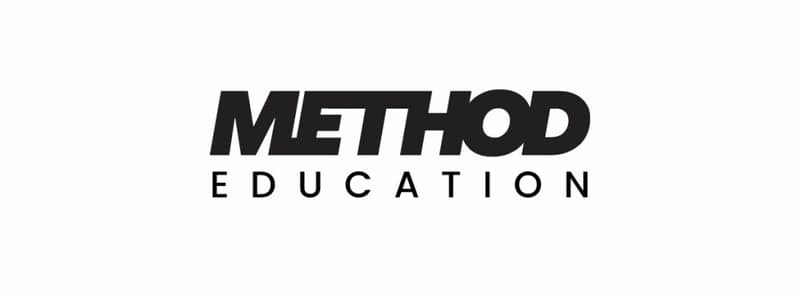Podcast
Questions and Answers
What is the main focus of fatigue management in strength training?
What is the main focus of fatigue management in strength training?
- Increasing weight without limits
- Maintaining consistent performance
- Maximizing recoverable volume (correct)
- Minimizing training sessions
Training below the maximal threshold results in optimal fatigue management.
Training below the maximal threshold results in optimal fatigue management.
False (B)
Define the term MRV in the context of strength training.
Define the term MRV in the context of strength training.
Maximum recoverable volume
All proper overloaded training will result in cumulative __________.
All proper overloaded training will result in cumulative __________.
Match the following principles with their descriptions:
Match the following principles with their descriptions:
What does MRV stand for in strength training?
What does MRV stand for in strength training?
Only increasing work capacity is necessary to improve MRV.
Only increasing work capacity is necessary to improve MRV.
What role does proper sleep and nutrition play in training?
What role does proper sleep and nutrition play in training?
Match the following terms with their descriptions:
Match the following terms with their descriptions:
What is the predominant source of glucose for powerlifting training?
What is the predominant source of glucose for powerlifting training?
Liver glycogen is primarily used for muscle contraction during strength training.
Liver glycogen is primarily used for muscle contraction during strength training.
What must be replenished with a diet adequate in carbohydrates?
What must be replenished with a diet adequate in carbohydrates?
When glycogen levels dwindle, one potential negative effect is diminished training ______.
When glycogen levels dwindle, one potential negative effect is diminished training ______.
Match the following effects of low glycogen levels with their descriptions:
Match the following effects of low glycogen levels with their descriptions:
Which physiological advantage do females have regarding fatigue dissipation?
Which physiological advantage do females have regarding fatigue dissipation?
Match the following factors with their effects on fatigue:
Match the following factors with their effects on fatigue:
Flashcards
Muscle Glycogen
Muscle Glycogen
A stored form of glucose in muscle tissue, crucial for high-intensity training.
Glycogen Depletion
Glycogen Depletion
Reduced glycogen levels in muscles, impacting training intensity, volume, and potentially leading to muscle loss.
Glycogen Replenishment
Glycogen Replenishment
Restoring glycogen stores through carbohydrate-rich diets following training to maintain performance.
Training Volume
Training Volume
Signup and view all the flashcards
Glycogen Source
Glycogen Source
Signup and view all the flashcards
MRV
MRV
Signup and view all the flashcards
Work Capacity
Work Capacity
Signup and view all the flashcards
Recovery
Recovery
Signup and view all the flashcards
Factors that Enhance MRV
Factors that Enhance MRV
Signup and view all the flashcards
Work Capacity vs. Recovery
Work Capacity vs. Recovery
Signup and view all the flashcards
Maximal Recoverable Volume (MRV)
Maximal Recoverable Volume (MRV)
Signup and view all the flashcards
Training Above Threshold
Training Above Threshold
Signup and view all the flashcards
Fatigue Management Principle
Fatigue Management Principle
Signup and view all the flashcards
Training Below Threshold
Training Below Threshold
Signup and view all the flashcards
Cumulative Fatigue
Cumulative Fatigue
Signup and view all the flashcards
Female Fatigue Differences
Female Fatigue Differences
Signup and view all the flashcards
Gender and Fiber Type
Gender and Fiber Type
Signup and view all the flashcards
Gender & Training Recovery
Gender & Training Recovery
Signup and view all the flashcards
Technique and Energy Expenditure
Technique and Energy Expenditure
Signup and view all the flashcards
Leverage and Fatigue
Leverage and Fatigue
Signup and view all the flashcards
Study Notes
Fatigue Management
- Training overloads the body to induce adaptations but also disrupts homeostasis. This disrupts 4 physiological groups: fuel stores, nervous system, chemical messengers, and tissue structure.
- Not all disruptions are completely healed between training sessions. The minimum frequency for training is addressed in a separate chapter.
- The intensity and volume of training sessions play a significant role in fatigue.
Fuel Stores
- Fuel stores are broken down into 3 categories: phosphagens (ATP and creatine phosphate), glucose/glycogen (stored glucose in muscle), and fat (stored in adipose tissue).
- When lifting heavy weights (<10 reps), ATP and glycolysis are the primary energy sources.
- Fat isn't a primary energy source during heavy lifting, but plays a role in recovery.
- Glycogen is used during intense training and must be replenished by a diet rich in carbohydrates.
The Nervous System
- The nervous system is involved in activating and coordinating skeletal muscle.
- Training, especially high-volume, heavy training, can disrupt the nervous system by causing imbalances in ions and messenger molecules between and within nerve cells.
- The neurotransmitter acetylcholine (Ach) is crucial in activation signals between motor neurons and muscles. Depletion of Ach can cause issues with training.
- Lifting that overloads the body disrupts the nervous system (PNS and CNS).
Chemical Messengers
- Autocrine messenger molecules like AMPK and mTOR, along with paracrine and endocrine molecules, play an integral role in the body's adaptive processes.
- These molecules are associated with fatigue, especially during sustained high-volume training.
- mTOR is activated by anabolic stimuli and involved in muscle growth.
- AMPk is activated during high-volume training and endurance activities.
Tissue Structures
- Muscle, fascia, tendons, ligaments, and bones can be damaged during training.
- Microscopic tears in these structures are common with heavy training, but are generally harmless.
- Chronically unhealed microtears and fractures can lead to larger areas of weakness, causing structural failure and injury.
Studying That Suits You
Use AI to generate personalized quizzes and flashcards to suit your learning preferences.



